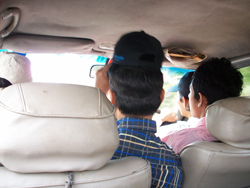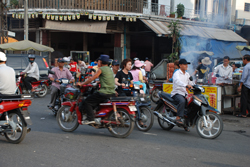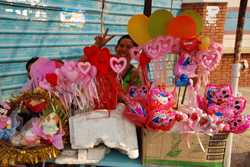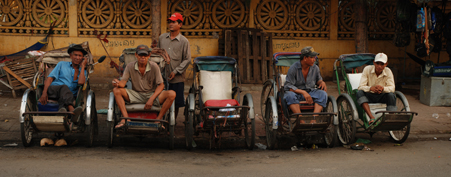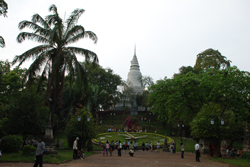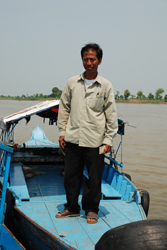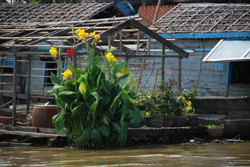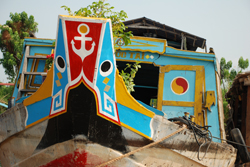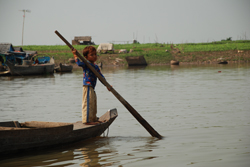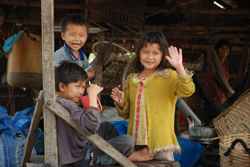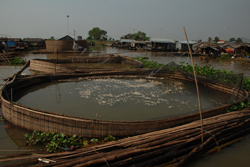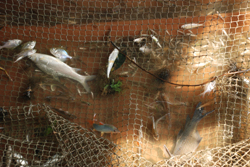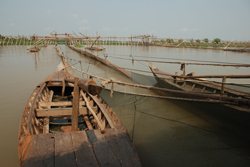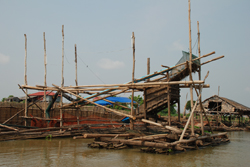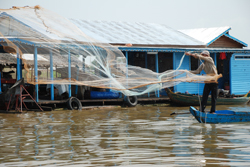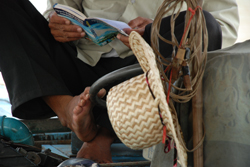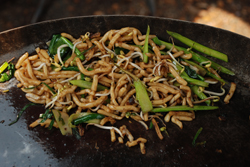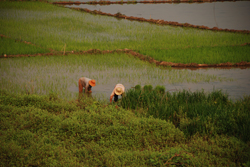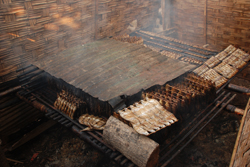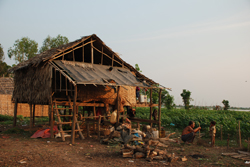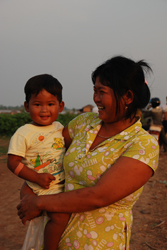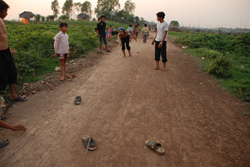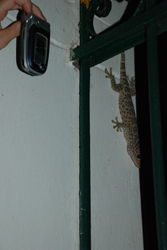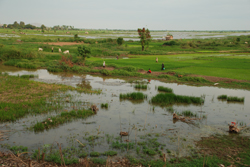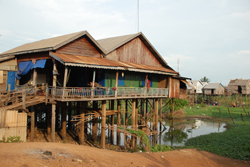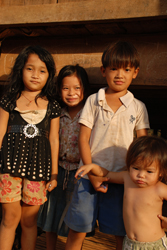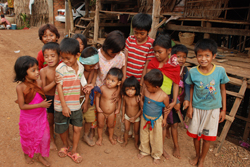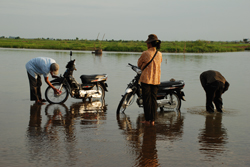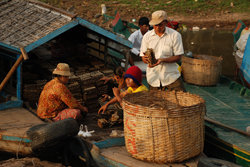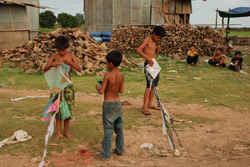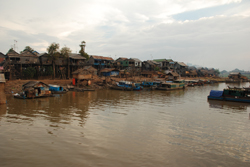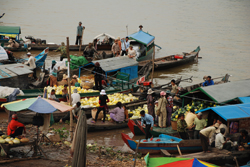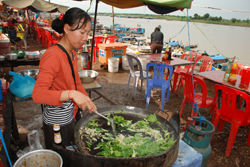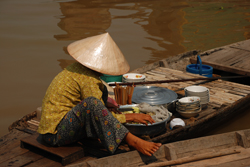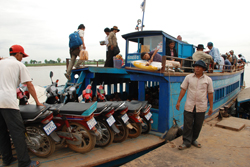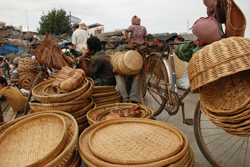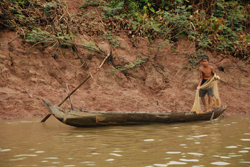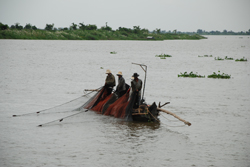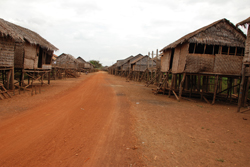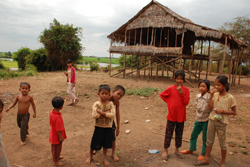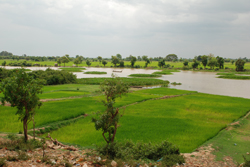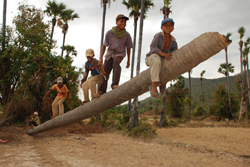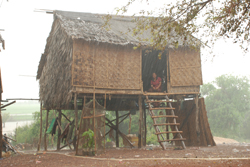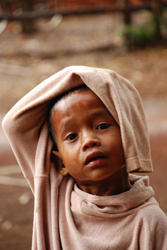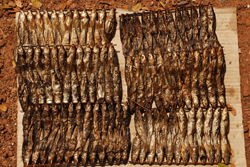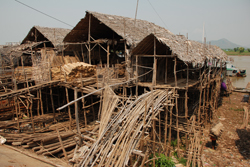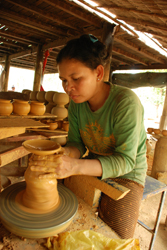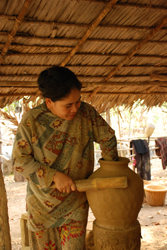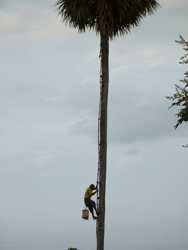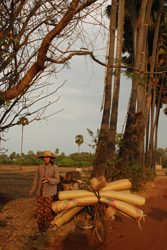Wandering around Phnom Penh
16 February, 2009, 03:54 am in "Cambodia"
We got to Phnom Penh easily-- $10 for the full back seat of the car. The driver stuck 3 more people in front-- a common practice. 2 were in the passenger seat and one in the driver's seat with the driver sitting on his lap. Do you suppose you pay less if the driver sits on your lap? Do pretty girls ride for free in that seat?
Phnom Penh so far hasn't been the most inviting of cities. It greeted us with dusty sprawl. It's polluted and dirty. All the cars and motorcycles probably add extra heat to the already high temperature. Also it is more expensive than other parts of Cambodia but you get less for your money. We arrived on Valentines Day so the sidewalks had lots of flower/balloon/cute love trinket sellers.
Phnom Penh so far hasn't been the most inviting of cities. It greeted us with dusty sprawl. It's polluted and dirty. All the cars and motorcycles probably add extra heat to the already high temperature. Also it is more expensive than other parts of Cambodia but you get less for your money. We arrived on Valentines Day so the sidewalks had lots of flower/balloon/cute love trinket sellers.
The riverside area of Phnom Penh is filled with tourist restaurants, bars, and cafes. We visited the National Museum. It is housed in a pretty wood building with tall open windows and a courtyard so there is lots of air circulating. The building is like the Thai/Cambodian palaces and wats but is a reddish colored wood instead of gold so it feels a bit more down to earth.
The exhibits were a lot of statues and items from Angkor and 18th and 19th century pieces. The 15th-17th century must have been some kind of dark ages in Cambodia because there were hardly any items. The 18th-19th century pieces looked Thai. There was an exhibit of old photos and engravings. The funny/sad thing is some of the subjects still look the same-- traditional stilt houses, rice paddies etc.
We walked by the palace while it was closed for lunch so didn't go in. We also visited a market where we had a decent lunch of rice, eggplant and green peppers. I'd been a bit wary of the food places where the dishes are all set out in the open already prepared, but they tasted good. Hopefully we'll be OK this evening. After lunch we hung out at a gourmet cookie place (which was also a cafe). The Camory cookie company has a sign out front saying “Eat 1 cookie and you can send a child to school for 1 day”. This is the kind of humanitarian work I can get into: hang out in a cafe, eating cookies... No child left behind... better order 5 more cookies.... (OK they are small). We had a cookie sampler of cashew nut, spice cookies, mocha, and shortbread. Tasty.
We walked by the palace while it was closed for lunch so didn't go in. We also visited a market where we had a decent lunch of rice, eggplant and green peppers. I'd been a bit wary of the food places where the dishes are all set out in the open already prepared, but they tasted good. Hopefully we'll be OK this evening. After lunch we hung out at a gourmet cookie place (which was also a cafe). The Camory cookie company has a sign out front saying “Eat 1 cookie and you can send a child to school for 1 day”. This is the kind of humanitarian work I can get into: hang out in a cafe, eating cookies... No child left behind... better order 5 more cookies.... (OK they are small). We had a cookie sampler of cashew nut, spice cookies, mocha, and shortbread. Tasty.
Phnom Penh is named after a hill (Phnom means “hill”). We walked to the “hill” and walked around it. The cicadas were deafening. The hill really is not too impressive. It is 27 meters high and has a wat on it. As I said before, Cambodia (at least the part we have been in) is not the most mountainous of regions.
Kampong Chhnang: Life on the River
13 February, 2009, 03:19 am in "Cambodia"
This morning but at breakfast Judith and Bill told us how they met a soldier on the boat ride back from Kampong Leaeng who told them about various aspects of river life-- fisheries, floating villages, etc. They asked him if he had any friends with boats and arranged to go boating today. The invited us and it sounded so nice, we couldn't refuse.
We caught motos down to the port. Judith and Bill's soldier friend couldn't come with us so we set off with the boat skipper, a casual, gentle looking individual with sun darkened skin, black hair and the slightest beginnings of wrinkles. His boat was covered which was a relief since even at 9:30 AM the sun was already hot. We were surprised to see life jackets and life preservers on the boat.
We caught motos down to the port. Judith and Bill's soldier friend couldn't come with us so we set off with the boat skipper, a casual, gentle looking individual with sun darkened skin, black hair and the slightest beginnings of wrinkles. His boat was covered which was a relief since even at 9:30 AM the sun was already hot. We were surprised to see life jackets and life preservers on the boat.
We didn't have to go far down the river before we were passing the floating villages. I had expected them to be stilt houses but they actually were more like houseboats with rafts below the small houses. Many seemed nicer and better built than the village stilt houses we'd seen. They had metal grates over the windows, bright blue paint and flowers and potted plants carefully arranged. Apparently most of the floating village residents are Vietnamese. Many had Chinese/Vietnamese New Year decorations around the entrances-- red with gold writing.
Outside each had at least one boat. Sometimes just a simple long row boat but other times bigger boats painted blue, red and yellow, some with eyes painted on the prow. Some houses had thatched walls, some wooden. All seemed to have a TV antenna. Fishing nets were sometimes draped drying around the house or stashed in bundles. The houses were open and we could see people lounging in hammocks. Children excitedly smiled and waved as we went by. Some areas had fish pens made from woven bamboo fences set into the river.
We crossed to the other side of the river where people processed fish paste. This was not the most pleasant of home-businesses since it involved fermenting fish and was highly pungent. The fish processing houses had pools for fish and straining screens.
We visited one where the fish were fermenting. The bottom of a boat was filled with headless fish and salt and weighed down so the fish were covered with a layer of brown river water. They stayed there until they fermented and then were taken to a straining place where the fish and water were sucked up a tube and sent through a metal screen. In the market, fish paste (prahok) is sold in open smelly vats that invariably have swarms of flies buzzing around them. It is one of the main ingredients in Cambodian food (hmmm... I'm having a sudden urge to eat pizza).
I guess the heads are processed somewhere else, we speculated, into a lower grade fish paste... ugh... I should also mention the houseboat toilets lead directly into the river.
From there we ventured into the second river and up towards what we thought was a bridge when we saw it yesterday. It turned out to be part of a seasonal fish catching plant. The wooden poles going across the river held the ends of fishing nets. The fish processing area was maybe 200 meters downstream and the nets stretched to it. The fish swam into the area and got trapped in the nets, unable to swim out. From the wood platform building we visited, the nets could be pulled in using a pulley system, and the fish removed. The fishery is a temporary structure and only exists during the dry season when the river is low. It is removed before the rainy season starts.
We visited one where the fish were fermenting. The bottom of a boat was filled with headless fish and salt and weighed down so the fish were covered with a layer of brown river water. They stayed there until they fermented and then were taken to a straining place where the fish and water were sucked up a tube and sent through a metal screen. In the market, fish paste (prahok) is sold in open smelly vats that invariably have swarms of flies buzzing around them. It is one of the main ingredients in Cambodian food (hmmm... I'm having a sudden urge to eat pizza).
I guess the heads are processed somewhere else, we speculated, into a lower grade fish paste... ugh... I should also mention the houseboat toilets lead directly into the river.
From there we ventured into the second river and up towards what we thought was a bridge when we saw it yesterday. It turned out to be part of a seasonal fish catching plant. The wooden poles going across the river held the ends of fishing nets. The fish processing area was maybe 200 meters downstream and the nets stretched to it. The fish swam into the area and got trapped in the nets, unable to swim out. From the wood platform building we visited, the nets could be pulled in using a pulley system, and the fish removed. The fishery is a temporary structure and only exists during the dry season when the river is low. It is removed before the rainy season starts.
Across, there was an island, an isolated sliver of green life against the brown of the river. Our boat driver had produced a phrase book and pointed out the crops grown-- cabbage, tomatoes, cucumbers, and watermelon.
There was a decent amount of activity on the river. We saw fishing boats with fishers throwing nets and woman in Vietnamese wide pointed hats row by transporting goods. On one fishing boat the fishers were pulling in their net. Its floats were made from aerosol cans.
There was a decent amount of activity on the river. We saw fishing boats with fishers throwing nets and woman in Vietnamese wide pointed hats row by transporting goods. On one fishing boat the fishers were pulling in their net. Its floats were made from aerosol cans.
Our boatman offered to show us his house. He had really warmed to Judith's pointing out, “Nice to meet you.” in his phrase book. In turn he pointed to “Give me regards to your family.” His house was close to shore but still floating. We were greeted by his wife, one of his daughters, and his youngest son. His daughter studied English and invited us in with, “Sit down please.” His second son appeared. We admired the photos on the wall of the family. Judith immediately went to them and asked about them. I admired how quickly she seized the opportunity for communicating with minimal language. The house was spotless and comfortably cool receiving a breeze from the water. There were a couple chairs, and a hammock. The kitchen had pots neatly hung from the walls and dishes were neatly stacked. The youngest son began to be more comfortable with us and less frightened. We didn't stay long and went back to the boat just as our skipper's 2nd daughter came home from school. His oldest daughter boarded the boat to help pole it away from an area of water hyacinths. Then we let her off on a nearby boat from which she walked from boat to house to get back to their house. (Though we never saw how she got over the gap of water from between the last house and her own.) Maybe one of her siblings pushed their boat over for her.
We reached the port after a restful but interesting 2 hours. We went up to the food stalls and had a lunch of worms... not really. The fried noodle makers have 3 kinds of noodles: thin yellow, wider fettuccine and short fat rice noodles that until you really look close, look like small earthworms.
We had them fried with vegetables and “kroeung” (gutteral KG-rew-ung) and served with a bit of the sweetened fish sauce on top. Pretty good though a bit hard to keep on the fork since they are kind of wiggly. We had “manoa” shakes (pineapple) to with them which hit the spot.
Rowshan and I took a walk along the river next to the floating village. It was dusk and the light was gentle though the air was still warm. Lots of kids played volleyball. A group of people played Bingo. One area had the houses where they smoked the fish. They were open shacks with palm thatch siding and corrugated metal roofs. There was a fire built in the bottom and the fish were on racks. There was a group of guys playing petanque using shoes and flip flops. Beyond them the houses got more spaced out and we were walking past fields with just small stilt houses.
Rowshan and I took a walk along the river next to the floating village. It was dusk and the light was gentle though the air was still warm. Lots of kids played volleyball. A group of people played Bingo. One area had the houses where they smoked the fish. They were open shacks with palm thatch siding and corrugated metal roofs. There was a fire built in the bottom and the fish were on racks. There was a group of guys playing petanque using shoes and flip flops. Beyond them the houses got more spaced out and we were walking past fields with just small stilt houses.
In the evening we saw a giant red spotted gecko on a wall near the hotel. We had seen tons of little geckos everywhere but never a giant red spotted one.
[ View 2 Comments
|
]
Kampong Chhnang: A Million Hellos
12 February, 2009, 03:19 am in "Cambodia"
The rice paddies are a lascivious green-- surprising in contrast to the brown of the river, mud, dirt, and thatched houses. This indecent brightness of green is beautiful, especially when the sky is cloudy white and gray. Kampong Chhnang is a small town a couple hours from Phnom Penh. It occupies a spot on the Tonle Sap river which I guess is what draws tourists... though there really are just a few here. We are here because it is a center for pottery. In fact “chhnang” is the word for a ceramic cooker made here.
The center of the town doesn't have many signs that the town is a major ceramics producer. There are some administrative buildings, shops and a market. Beyond the center the roads become dirt and run between rows of stilt houses with pools of stagnant water and mud underneath. Some had grounded wooden boats underneath waiting for the rainy season. Between the houses are fields, marsh or ponds. During the rainy season the marshes and fields become part of the river and the town becomes a floating village.
All the children and many adults say, “Hi” when we walk by. It feels like we've said, “hello” a million times. We came upon a group of kids who had been playing a game of dress up with scraps of colored cloth.
From the village street we finally reached part of the river-- an active waterway. One section was so low there was a road of concrete across it--- maybe a dam. People were washing cars and motorbikes on it. I also saw dishes, and a puppy being washed as well as a guy giving himself a bath. Kids flew kites made form colored plastic bags. Beyond the “dam” multicolored boats unloaded packages of small silver fish.
The proper river has a busy harbor, a small market and street food vendors and fruit shake makers who set up their tables with a view of the river and islands beyond.
Today we rented a motorcycle. We had met another couple at the hotel, Judith and Bill, from Canada. They also rented a bike and had gotten information from the hotel owner about a loop through the countryside. As Rowshan and I drove away from the hotel we noticed the sky looked ominously gray. We returned to the hotel and got our ponchos even though the hotel manager assured us there wouldn't be any rain. There we noticed our front tire was fairly worn. We took it back to the guy Rowshan had rented it from but the only other bike he'd offer us was $20 instead of $5 like the one we had. They insisted it would be fine since the roads were dry. We decided it would do and went on our way.
We biked to the waterfront where boat touts tried to get us to hire a boat for $30 to Kampong Leah. The hotel manger had said it should cost $6 for all of us. No bargaining would bring them down. Then I saw a large boat a bit farther down that looked like a public ferry. The boat touts said it was “cheap cheap”. A bit annoyed they hadn't told us earlier, we headed over. We paid a guy to drag our bikes down the stairs and soon they were loaded on the boat. We joined the people on the roof. There was a basket vendor with woven baskets and ladles loaded on a bicycle.
We biked to the waterfront where boat touts tried to get us to hire a boat for $30 to Kampong Leah. The hotel manger had said it should cost $6 for all of us. No bargaining would bring them down. Then I saw a large boat a bit farther down that looked like a public ferry. The boat touts said it was “cheap cheap”. A bit annoyed they hadn't told us earlier, we headed over. We paid a guy to drag our bikes down the stairs and soon they were loaded on the boat. We joined the people on the roof. There was a basket vendor with woven baskets and ladles loaded on a bicycle.
The boat ride was technically taking us across one river-- the Tonle Sap. However, during the dry season it becomes 3 rivers separated by islands and spits down the center. The boat zig-zaged up and down the rivers to make it through the channels left attaching the rivers. It is hard to imagine how different the whole area must be with the rains.
We reached the other side of the three rivers and headed down the dirt road between the houses. Beyond was a splendid view of rice paddies, patches of water, and clouds. People worked in the paddies creating the quintessential image of SE Asia. We headed inland and soon were through the village and riding next to fields with scattered trees and hills beyond. In one field kids were using a down palm tree as a seesaw. I guess the roots still held but the trunk went out horizontal. They sat and bounced and it sent them flying into the air.
We went on and about ¼ of the way around the loop it started to rain. Even though there was a chance it would stop, we were worried about the worn tire and potentially muddy roads. So we went back. A little ways on the rain stopped and the sun came out. We took another road, perhaps the other end of the loop and found it a pleasant path between fields and paddies. We passed a woman carrying firewood on her head. She seemed to be telling us not to go further. I don't know if she meant there was nothing there or just warning us of inclement weather. The clouds convinced us to turn back. We reached the village and it began to pour. We stopped under a tree and a woman told us to go to one of the houses.
A bamboo ladder led to a bamboo platform which served as a foyer. Beyond that was a wooden platform which held a bed. A girl and an older woman were there. A couple children climbed up drenched from the rain. They didn't know English and we don't know Khmer so our conversation was limited. The rain let up for a little and we decided we could leave so thanked our hosts and left. Naturally, as we started driving it started raining again. We got to the dock which fortunately had a covered area.
There we learned the next boat wasn't for an hour and a half. Since other people were waiting as well, we hired a boat together to take us back to Kampong Chhnang. The regular boat is cheaper but aside from not having to wait, we had the advantage of not sharing the covered area of the public ferry with several unfortunate pigs who were there tied up and squealing in a heart rending manner.
The sun came out as we left the port and when we got to Kampong Chhnang, the weather was nice enough to sit outside and eat lunch on the waterfront. Our truncated trip to the countryside left us with time to visit the pottery village which was the main reason we came to Kampong Chhnang in the first place.
The sun came out as we left the port and when we got to Kampong Chhnang, the weather was nice enough to sit outside and eat lunch on the waterfront. Our truncated trip to the countryside left us with time to visit the pottery village which was the main reason we came to Kampong Chhnang in the first place.
The potter villages are also countryside but they are in a more forested area. The heat of the sun drew the scent of the plants into the air on the steam of the rainy dampness. The scent was savory-- a delicate exotic heady blend.
Most of the pottery seemed to be created in home workshops. Going by we could see pots drying underneath the houses and sometimes piles of clay. We stopped by one where a young woman was throwing a piece on a wheel and another woman was shaping a piece by pounding it with a hammer.
Most of the pottery seemed to be created in home workshops. Going by we could see pots drying underneath the houses and sometimes piles of clay. We stopped by one where a young woman was throwing a piece on a wheel and another woman was shaping a piece by pounding it with a hammer.
At a more formal shop-- the Ceramic Development Center of Ondoung Rossey Village Cambodian Craft Corporation which was supported by several German organizations-- women made finer terracotta pieces including vases, teapots, cups and trinkets.
As we were in the yard looking at some of their rougher traditional-style pots for cooking, we heard laughter. I didn't see anyone as I looked around. Then the woman at the ceramics place pointed to the top of a palm tree.
The area next to the ceramics place was a field with tall palms stretching to the sky. In the top of one, a young man was laughing. His voice carried and seemed disembodied until we saw him in the tree. Replies and laughter came from the tops of other trees as the palm syrup harvesters bantered with each other.
The area next to the ceramics place was a field with tall palms stretching to the sky. In the top of one, a young man was laughing. His voice carried and seemed disembodied until we saw him in the tree. Replies and laughter came from the tops of other trees as the palm syrup harvesters bantered with each other.
The palm syrup is collected by hanging plastic water/soda bottles from the ends of cut palm branches. The palms are tall and ladders to aid climbing have been built up the trunk using a bamboo tree with the branches cut off, leaving just their stumps for rungs. The men climbed down the trees carrying the filled bottles.
[ View 2 Comments
|
]
Powered by My Blog 1.69. Copyright 2003-2006 FuzzyMonkey.net.
Created by the scripting wizards at FuzzyMonkey.net..
(Code modified by Rowshan Dowlatabadi)
Created by the scripting wizards at FuzzyMonkey.net..
(Code modified by Rowshan Dowlatabadi)


